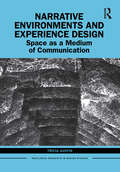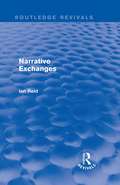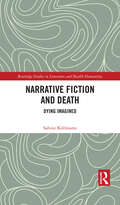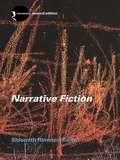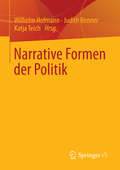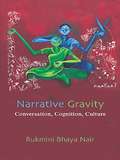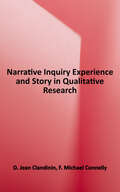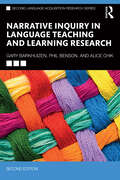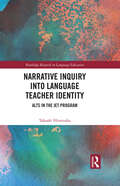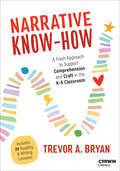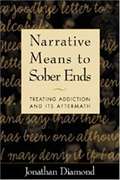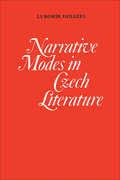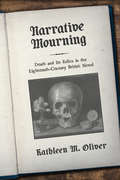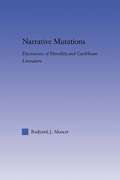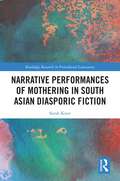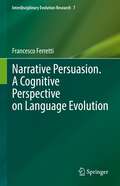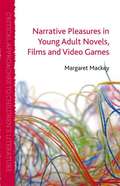- Table View
- List View
Narrative Environments and Experience Design: Space as a Medium of Communication (Routledge Research in Design Studies)
by Tricia AustinThis book argues narrative, people and place are inseparable and pursues the consequences of this insight through the design of narrative environments. This is a new and distinct area of practice that weaves together and extends narrative theory, spatial theory and design theory. Examples of narrative spaces, such as exhibitions, brand experiences, urban design and socially engaged participatory interventions in the public realm, are explored to show how space acts as a medium of communication through a synthesis of materials, structures and technologies, and how particular social behaviours are reproduced or critiqued through spatial narratives. This book will be of interest to scholars in design studies, urban studies, architecture, new materialism and design practitioners in the creative industries.
Narrative Exchanges (Routledge Revivals)
by Ian ReidFirst published in 1992, Narrative Exchanges shows how a general model of communicative exchanges can be refined to deal with the complexities of narrative fiction. Going beyond the two-way structure of reciprocity, it gives particular attention to the processes of framing, substitution and dispossession by which written texts generate meaning. The title provides an innovative way of combining narrative and exchange theory, bringing the two areas of thought into a mutually critical relationship. Using a wide variety of narrative texts, literary and non-literary, canonical and non-canonical, authors discussed include Flaubert, Achebe, Mansfield, Boccaccio, Duras, Daudet, Moorhouse, DeLillo and Wordsworth. Drawing on perspectives from anthropology, linguistics and education, and combining accessible readings with theoretical debate, Ian Reid makes a significant contribution to the debate about narrative theory.
Narrative Fiction and Death: Dying Imagined (Routledge Studies in Literature and Health Humanities)
by Sabine KöllmannNarrative Fiction and Death: Dying Imagined offers a new perspective on the study of death in literature. It focuses on narrative fiction that conveys the experience of dying from the internal perspective of a dying protagonist. Writers from Victor Hugo in the early 1800s to Elif Shafak in the present day have imagined the unknowable final moments on the threshold to death. This literary study examines the wide range of narrative strategies used to evoke the transition from life to death, and to what effect, revealing not only each writer’s unique way of representing the dying experience; the comparative reading also finds common concerns in these texts and uncovers surprising parallels and unexplored intertextual relations between works across time and space that will interest comparatists as well as specialists in the literatures discussed. Students of individual texts examined here will benefit from detailed analyses of these works. The fictional evocation of dying addresses our basic human fears, offering catharsis, consolation, and a greater cognitive and emotional understanding of that unknowable experience. Presented in an engaging and highly readable manner, this study argues for literature’s potential to challenge our assumptions about the end of life and change our approach to dying, an aspect that will interest students and researchers of the health humanities, palliative caregivers, and all those interested in questions of the end of life.
Narrative Fiction: Contemporary Poetics
by Shlomith Rimmon-KenanWhat is a narrative? What is narrative fiction? How does it differ from other kinds of narrative? What featuers turn a discourse into a narrative text? Now widely acknowledged as one of the most significant volumes in its field, Narrative Fiction turns its attention to these and other questions. In contrast to many other studies, Narrative Fiction is organized arround issues - such as events, time, focalization, characterization, narration, the text and its reading - rather than individual theorists or approaches. Within this structure, Shlomith Rimmon-Kenan addresses key approaches to narrative fiction, including New Criticism, formlaism, structuralism and phenomenology, but also offers views of the modifications to these theroies. While presenting an analysis of the system governing all fictional narratives, whether in the form of novel, short story or narrative poem, she also suggests how individual narratives can be studied against the background of this general system. A broad range of literary examples illustrate key aspects of the study. This edition is brought fully up-to-date with an invaluable new chapter, reflecting on recent developments in narratology. Readers are also directed to key recent works in the field. These additions to a classic text ensure that Narrative Fiction will remain the ideal starting point for anyone new to narrative theory.
Narrative Form: Revised and Expanded Second Edition
by Suzanne KeenThis revised and expanded handbook concisely introduces narrative form to advanced students of fiction and creative writing, with refreshed references and new discussions of cognitive approaches to narrative, nonfiction, and narrative emotions.
Narrative Formen der Politik
by Wilhelm Hofmann Judith Renner Katja TeichDie Politikwissenschaft thematisiert seit geraumer Zeit in den verschiedensten Zusammenhängen die diskursive Konstitution politischer Realität. Die Erkenntnis, dass Politik wesentlich eine diskursive Dimension hat, führt in fast allen Teildisziplinen zu einer ganzen Reihe von intensiv verfolgten Anschlussfragen. Im Kontext dieses Interesses an der diskursiven Konstruktion des Politischen wendet sich der vorliegende Band besonders der narrativen Dimension des Politischen und den Formen ihrer Erforschung zu. Er bietet eine erste Annäherung an das noch junge Forschungsfeld der narrativen Politiken und diskutiert den Mehrwert der Analyse narrativer Strukturen und des politischen Erzählens für die verschiedenen Teildisziplinen der Politikwissenschaft.
Narrative Gravity: Conversation, Cognition, Culture
by Rukmini Bhaya NairIn this elegantly written and theoretically sophisticated work, Rukmini Bhaya Nair asks why human beings across the world are such compulsive and inventive storytellers. Extending current research in cognitive science and narratology, she argues that we seem to have a genetic drive to fabricate as a way of gaining the competitive advantages such fictions give us. She suggests that stories are a means of fusing causal and logical explanations of 'real' events with emotional recognition, so that the lessons taught to us as children, and then throughout our lives via stories, lay the cornerstones of our most crucial beliefs. Nair's conclusion is that our stories really do make us up, just as much as we make up our stories.
Narrative Hospitality in Late Victorian Fiction: Novel Ethics (Routledge Studies in Nineteenth Century Literature)
by Rachel HollanderBringing together poststructuralist ethical theory with late Victorian debates about the morality of literature, this book reconsiders the ways in which novels engender an ethical orientation or response in their readers, explaining how the intersections of nation, family, and form in the late realist English novel produce a new ethics of hospitality. Hollander reads texts that both portray and enact a unique ethical orientation of welcoming the other, a narrative hospitality that combines the Victorians’ commitment to engaging with the real world with a more modern awareness of difference and the limits of knowledge. While classic nineteenth-century realism rests on a sympathy-based model of moral relations, novels by authors such as George Eliot, Thomas Hardy, and Olive Schreiner present instead an ethical recognition of the distance between self and other. Opening themselves to the other in their very structure and narrative form, the visited texts both represent and theorize the ethics of hospitality, anticipating twentieth-century philosophy’s recognition of the limits of sympathy. As colonial conflicts, nationalist anxiety, and the intensification of the "woman question" became dominant cultural concerns in the 1870s and 80s, the problem of self and other, known and unknown, began to saturate and define the representation of home in the English novel. This book argues that in the wake of an erosion of confidence in the ability to understand that which is unlike the self, a moral code founded on sympathy gave way to an ethics of hospitality, in which the concept of home shifts to acknowledge the permeability and vulnerability of not only domestic but also national spaces. Concluding with Virginia Woolf’s reexamination of the novel’s potential to educate the reader in negotiating relations of alterity in a more fully modernist moment, Hollanders suggest that the late Victorian novel embodies a unique and previously unrecognized ethical mode between Victorian realism and a post-World- War-I ethics of modernist form.
Narrative Innovation and Incoherence: Ideology in Defoe, Goldsmith, Austen, Eliot, and Hemingway
by Michael M. BoardmanWhen the impulse toward innovation arises late in a writer's career, it is often accompanied by a sense of urgency, and the result, as Narrative Innovation and Incoherence demonstrates, raises important questions for literary theory. Michael M. Boardman considers this pressing struggle to find a new form as it appears in the later works of Defoe, Goldsmith, Austen, Eliot, and Hemingway. He analyzes how these authors react to new and compelling beliefs for which a previous way of writing is no longer adequate.Urgent innovations, in this account, can only be understood as unique, individual responses to crises in belief. Taking as a point of departure French theorist Althusser's conviction that ideology is intelligible only through structure, Boardman searches for an explanation of both form and ideology not in Marxist concepts of base and superstructure but in the particular structure of an individual artist's writing career. Narrative ideology here becomes more complex than is generally assumed.Theoretically informed yet avoiding essentializing explanations of narrative invention, Narrative Innovation and Incoherence offers unexpected insights into the multifaceted relations between form and belief. It will encourage serious students of the novel to reexamine the importance of poetics as a mediating factor in the means of production.
Narrative Inquiry Experience and Story in Qualitative Research: Experience And Story In Qualitative Research
by D. Jean Clandinin F. Michael Connelly"The literature on narrative inquiry has been, until now, widely scattered and theoretically incomplete. Clandinin and Connelly have created a major tour de force. This book is lucid, fluid, beautifully argued, and rich in examples. Students will find a wealth of arguments to support their research, and teaching faculty will find everything they need to teach narrative inquiry theory and methods."--Yvonna S. Lincoln, professor, Department of Educational Administration, Texas A+M University. Understanding experience as lived and told stories--also known as narrative inquiry--has gained popularity and credence in qualitative research. Unlike more traditional methods, narrative inquiry successfully captures personal and human dimensions that cannot be quantified into dry facts and numerical data. In this definitive guide, Jean Clandinin and Michael Connelly draw from more than twenty years of field experience to show how narrative inquiry can be used in educational and social science research. Tracing the origins of narrative inquiry in the social sciences, they offer new and practical ideas for conducting fieldwork, composing field notes, and conveying research results. Throughout the book, stories and examples reveal a wide range of narrative methods. Engaging and easy to read, Narrative Inquiry is a practical resource from experts who have long pioneered the use of narrative in qualitative research.
Narrative Inquiry in Language Teaching and Learning Research (ISSN)
by Phil Benson Alice Chik Gary BarkhuizenNarrative Inquiry in Language Teaching and Learning Research is the only entry-level introduction to research methods using stories, either as data or as a means of presenting findings, and a practical guide for those interested in carrying out narrative studies.This successful text is grounded in published empirical research within the field of language teaching and learning and clearly defines basic concepts in narrative inquiry, explaining how and why narrative methods have been used in language teaching and learning research and outlining different choices and approaches. It also examines the different ways of eliciting, analyzing, and presenting narrative inquiry data, which offers exciting prospects for language teaching and learning research. This second edition has been fully revised and updated to reflect the latest research and includes new sections on multimodal digital narrative research and the reporting of findings in dissertations and theses.This original and well-respected textbook is an ideal course book for specialist courses on narrative inquiry in language teaching and learning. It is an excellent entry-level text for undergraduate students preparing honours projects, postgraduate masters’ and doctoral students embarking on narrative projects, and more advanced researchers seeking to understand the role of narrative inquiry in language teaching and learning research. It is also the go-to choice as a reference on narrative in more general applied linguistics research methodology courses.
Narrative Inquiry in Language Teaching and Learning Research: Narrative Inquiry In Language Teaching And Learning Research (Second Language Acquisition Research Series)
by Phil Benson Alice Chik Gary BarkhuizenNarrative Inquiry in Language Teaching and Learning Research provides an entry-level introduction to research methods using stories, as data or as a means of presenting findings, that is grounded in published empirical research within the field of language teaching and learning. It discusses basic definitions and concepts in narrative inquiry, explains how and why narrative methods have been used in language teaching and learning research, and outlines the different approaches and topics covered by this research. It also examines the different ways of eliciting, analyzing, and presenting narrative inquiry data.Narrative inquiry offers exciting prospects for language teaching and learning research and this book is the first focused and practical guide for readers who are interested in understanding or carrying out narrative studies.
Narrative Inquiry into Language Teacher Identity: ALTs in the JET Program (Routledge Research in Language Education)
by Takaaki HiratsukaThis book provides insights for both native language teachers and local language teachers alike who conduct team-taught lessons by revisiting the topic of foreign assistant language teachers (ALTs), the Japan Exchange and Teaching (JET) program, and team teaching. This book is innovative in that (a) it is the first to elucidate ALTs’ experiences comprehensively, across both historical time (i.e., prior to, during, and after the JET program) and social space (i.e., inside and outside the school), thereby revealing their multiple identities that they come to construct and reconstruct over time, and (b) it explores the meanings and perspectives of particular phenomena that ALTs experience within their specific social settings from their own individual points of view. This inquiry does this by using personal narrative accounts gathered from multiple participants. Through these narrative accounts, Hiratsuka formulates a conceptualization of ALT identity, an effort that has hitherto been neglected. As a consequence, this book offers several practical and empirical applications of the conceptualization to future endeavors involving native language teachers and those who engage with them, including the key stakeholders of local language teachers, their local boards of education, the governments, and language learners across the globe.
Narrative Know-How: A Fresh Approach to Support Comprehension and Craft in the K–6 Classroom (Corwin Literacy)
by Trevor Andrew BryanTeach your students to grasp the structure of narratives with this simple, yet powerful approach! Teaching text structure has never been easier or more engaging. Narrative Know-How: A Fresh Approach to Support Comprehension and Craft in the K–6 Classroom equips educators with innovative tools to help students understand the structure of stories, improving both their reading comprehension and their ability to craft compelling narratives. Through his unique Mood Structures strategy, Trevor Bryan offers a simple yet powerful way for students to connect with fiction and nonfiction texts alike. Whether you′re aiming to boost engagement, make complex ideas more accessible, or bring joy back to your literacy lessons, this book delivers. Designed to help young readers and writers thrive, this resource focuses on actionable strategies and practical lessons tested in real classrooms. Teachers will gain the tools they need to develop students’ narrative comprehension, improve written expression, and foster critical thinking skills. Offering a fresh approach to comprehension and narrative writing, this research-backed book Provides a proven instructional sequence that connects reading and writing to enable students to seamlessly build comprehension and composition skills Addresses key narrative elements such as mood, symbolism, and themes in both reading and writing through 20 classroom-tested lessons Helps students understand narrative principles with more than 20 extensive mentor texts examples and accompanying deconstructions Includes original illustrations from the award-winning author-illustrator, Jarrett Lerner, visual tools, graphic organizers and guided response sheets that enhance engagement and make the approach easy to access for every learner Trevor Bryan’s groundbreaking instructional strategies make literacy instruction purposeful, practical, and fun. With Narrative Know-How, educators will inspire their students to think critically, write skillfully, and read with deeper insight.
Narrative Know-How: A Fresh Approach to Support Comprehension and Craft in the K–6 Classroom (Corwin Literacy)
by Trevor Andrew BryanTeach your students to grasp the structure of narratives with this simple, yet powerful approach! Teaching text structure has never been easier or more engaging. Narrative Know-How: A Fresh Approach to Support Comprehension and Craft in the K–6 Classroom equips educators with innovative tools to help students understand the structure of stories, improving both their reading comprehension and their ability to craft compelling narratives. Through his unique Mood Structures strategy, Trevor Bryan offers a simple yet powerful way for students to connect with fiction and nonfiction texts alike. Whether you′re aiming to boost engagement, make complex ideas more accessible, or bring joy back to your literacy lessons, this book delivers. Designed to help young readers and writers thrive, this resource focuses on actionable strategies and practical lessons tested in real classrooms. Teachers will gain the tools they need to develop students’ narrative comprehension, improve written expression, and foster critical thinking skills. Offering a fresh approach to comprehension and narrative writing, this research-backed book Provides a proven instructional sequence that connects reading and writing to enable students to seamlessly build comprehension and composition skills Addresses key narrative elements such as mood, symbolism, and themes in both reading and writing through 20 classroom-tested lessons Helps students understand narrative principles with more than 20 extensive mentor texts examples and accompanying deconstructions Includes original illustrations from the award-winning author-illustrator, Jarrett Lerner, visual tools, graphic organizers and guided response sheets that enhance engagement and make the approach easy to access for every learner Trevor Bryan’s groundbreaking instructional strategies make literacy instruction purposeful, practical, and fun. With Narrative Know-How, educators will inspire their students to think critically, write skillfully, and read with deeper insight.
Narrative Machine: The Naturalist, Modernist, and Postmodernist Novel (Narrative Theory and Culture)
by Zena MeadowsongNarrative Machine: The Naturalist, Modernist, and Postmodernist Novel advances a new history of the novel, identifying a crucial link between narrative innovation and the historical process of mechanization. In the late nineteenth century, the novel grapples with a new and increasingly acute problem: In its attempt to represent the colossal power of modern machinery—the steam-driven machines of the Industrial Revolution, the electrical machines of the modern city, and the atomic and digital machines developed after the Second World War—it encounters the limitations of traditional representative strategies. Beginning in the naturalist novel, the machine is typically portrayed as a mythic monster, and though that monster represents a potentially horrific reality—the superhuman power of mechanization—it also disrupts the documentary objectives of narrative realism (the dominant mode of nineteenth-century fiction). The mechanical monster, realistic and yet at odds with traditional realist strategies, tears the form of the novel apart. In doing so, it unleashes a series of innovations that disclose, critique, and contest the force of mechanization: the innovations associated with literary naturalism, modernism, and postmodernism.
Narrative Means to Sober Ends: Treating Addiction and Its Aftermath
by Jonathan Diamond David C. TreadwayProposes a narrative approach that builds a bridge between family therapy, psychodynamic therapy, and addictions counseling. Demonstrates innovative ways to help clients form new understandings of the events of their lives, explore their relationships to drugs and alcohol, and develop new stories to nourish their recovery. Central to this approach is the use of letter writing, personal accounts, and other creative tasks. Diamond has been teaching and training in the fields of addiction and psychotherapy for the past 15 years. He is currently in private practice. Annotation c. Book News, Inc., Portland, OR (booknews.com)
Narrative Medicine: A Rhetorical Rx
by James PhelanNarrative Medicine: A Rhetorical Rx rests on the principles that storytelling is central to medical encounters between caregivers and patients and that narrative competence enhances medical competence. Thus, the book's goal is to develop the narrative competence of its reader. Grounded in the rhetorical theory of narrative that Phelan has been constructing over the course of his career, this volume utilizes a three-step method: Offering a jargon-free explication of core concepts of narrative such as character, progression, perspective, time, and space. Demonstrating how to use those concepts to interpret a diverse group of medical narratives, including two graphic memoirs. Pointing to the relevance of those demonstrations for caregiver-patient interactions. Narrative Medicine: A Rhetorical Rx is the ideal volume for undergraduate students interested in pursuing careers in healthcare, students in medical and allied health professional schools, and graduate students in the health humanities and social sciences.
Narrative Modes in Czech Literature
by Lubomir DolezelIn this study of the study of the linguistic approach to narrative structures, the author examines the question of point of view in fiction, drawing examples from Czech literature. He applies the methods of structural linguistics and literary studies as developed by the Prague Linguistic School, and the modern methodology of semiotics and text theory. This approach, widely used in Czechoslovakia and elsewhere in Europe, is not as well known as it should be in the English-speaking world. The essays may be read without any knowledge of the Czech language or Czech literary history. All Czech examples and materials are translated into English, preserving traits of the original texts which are relevant for structural analysis; the original Czech of all examples appears in an appendix. While the examples serve as documentation for theoretical statements, they also serve to familiarize the English-speaking reader with some of the major works of Czech fiction, especially those of Komenský (Comenius), Rais Ĉapek, Vanĉura, Pujmanová, Olbrachtm and Kundera. These works demonstrate the continuous bond between Czech fiction and European literary traditions, and offer original and profound insights into the cultural, social, and political experience of the Czech nation. Of particular interest to specialists in Slavic studies, general linguistics, poetics and text theory, and to students of general and comparative literature, Narrative Modes in Czech Literature deals with a significant problem of poetics and makes an original, constructive contribution to the theory of literature in the English language.
Narrative Mourning: Death and Its Relics in the Eighteenth-Century British Novel (Transits: Literature, Thought & Culture 1650-1850)
by Kathleen M. OliverNarrative Mourning explores death and its relics as they appear within the confines of the eighteenth-century British novel. It argues that the cultural disappearance of the dead/dying body and the introduction of consciousness as humanity’s newfound soul found expression in fictional representations of the relic (object) or relict (person). In the six novels examined in this monograph—Samuel Richardson's Clarissa and Sir Charles Grandison; Sarah Fielding's David Simple and Volume the Last; Henry Mackenzie's The Man of Feeling; and Ann Radcliffe's The Mysteries of Udolpho—the appearance of the relic/relict signals narrative mourning and expresses (often obliquely) changing cultural attitudes toward the dead. Published by Bucknell University Press. Distributed worldwide by Rutgers University Press.
Narrative Mutations: Discourses of Heredity and Caribbean Literature (Literary Criticism and Cultural Theory)
by Rudyard AlcocerGiven the welcomed shift throughout the academy away from essentialist and biologically fixed understandings of "race" and the body, it is a curiosity worth exploring that so many sophisticated-and even radical-narratives retain physical and behavioral heredity as a guiding trope. The persistence of this concept in Caribbean literature informs not only discourses on race, ethnicity, and sexuality, but also conceptions of personal and regional identity in a postcolonial societies once dominated by slavery and the plantation. In this book, Rudyard Alcocer offers a theory of Caribbean narrative, accounting for the complex interactions between scientific and literary discourses while expanding the horizons of narrative studies in general. Covering works from Jean Rhys's Wide Sargasso Sea through contemporary fiction from the Hispanic Caribbean, Narrative Mutations analyzes the processes and concepts associated with heredity in exploring what it means to be "Caribbean."
Narrative Organizations: Making Companies Future Proof by Working With Stories (Management for Professionals)
by Michael Müller Christine ErlachThis book shows how to work with stories and narrative approaches in almost all fields of action of a company, and demonstrates the added value resulting from a holistic narrative perspective. The authors take thereby a practice-based perspective from the viewpoint of managing directors, the C-suite, organizational developers, corporate communicators and advisers with a rich description of the methods and implementation.By the employment of these narrative methods, leadership styles, communication, knowledge and change management can be planned in such a way that on the one hand the identity-core of the enterprise remains always apparent and on the other, the organization can develop in an agile fashion into the future.
Narrative Performances of Mothering in South Asian Diasporic Fiction (Routledge Research in Postcolonial Literatures)
by Sarah KnorExamining a range of South Asian Anglophone diasporic fiction and poetry, this monograph opens a new dialogue between diaspora studies and gender studies. It shows how discourses of diaspora benefit from re-examining their own critical relation to concepts of the maternal and the motherland. Rather than considering maternity as a fixed or naturally given category, it challenges essentialist conceptions and explores mothering as a performative practice which actively produces discursive meaning. This innovative approach also involves an investigation of central metaphors in nationalist and diasporic rhetorics, bringing critical attention to the strategies they employ and the unique aesthetic forms they produce.
Narrative Persuasion. A Cognitive Perspective on Language Evolution (Interdisciplinary Evolution Research #7)
by Francesco FerrettiThis book explores the evolutionary and cognitive foundations of human communication, focusing on narrative as its distinctive dimension. Within a framework of continuity with both the communication of our hominin predecessors and that of non-human animals, the book is about a twofold proposal. It includes the idea that (human and animal) communication has an intrinsically persuasive nature along with the hypothesis that humans developed narrative forms of communication in order to enhance their persuasive abilities. In this view, narrative persuasion becomes the feature that distinguishes human communication from animal communication. The study of the transition from animal communication to language addresses both the selective pressures that led communication for persuasive purposes to take a narrative form and the cognitive architectures and expressive systems that enabled our ancestors to cope with the selective pressures of persuasive/narrative-based communication. Language evolution is interdisciplinary, even from the specific perspective of evolutionary pragmatics chosen here. Therefore, this book is intended for researchers working in fields such as cognitive sciences, philosophy, evolutionary biology, cognitive psychology, and primatology. It also represents a valuable resource for advanced students in cognitive sciences, linguistics, and philosophy.
Narrative Pleasures in Young Adult Novels, Films, and Video Games
by Margaret MackeyStories are told today through many formats and young interpreters bring multimedia experience to bear on every narrative format they encounter. In this book, twelve young people read a novel, watch a film and play a video game from beginning to end. Their responses inform a new framework of contemporary themes of narrative comprehension.
